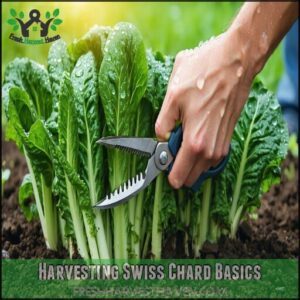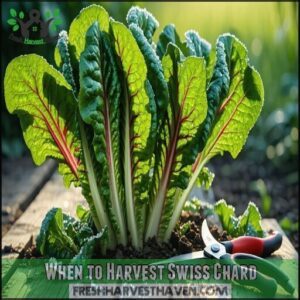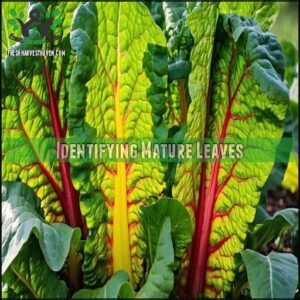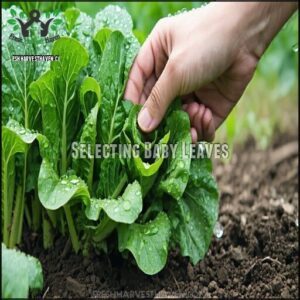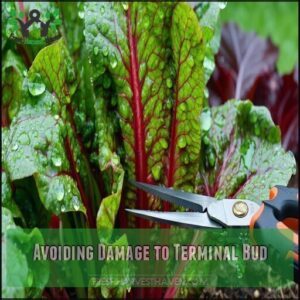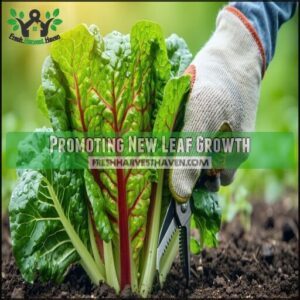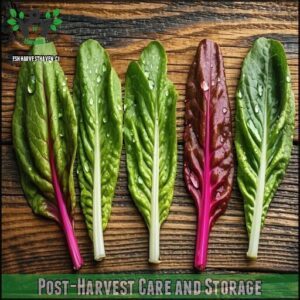This site is supported by our readers. We may earn a commission, at no cost to you, if you purchase through links.
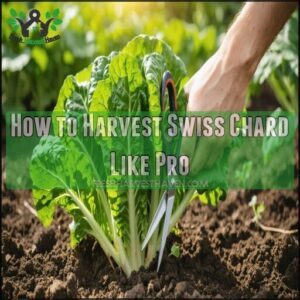
Aim to leave 4-5 central leaves so the plant stays productive.
For baby greens, trim the leaves about 3 inches above the soil, which promotes regrowth—think of it as giving your plant a stylish haircut.
Skip any leaves that look yellowed or damaged.
A well-timed harvest guarantees peak flavor and tenderness, and if you play your cards right, your chard will keep producing all season long!
Table Of Contents
- Key Takeaways
- Harvesting Swiss Chard Basics
- When to Harvest Swiss Chard
- Choosing The Right Leaves
- Harvesting Techniques and Tips
- Post-Harvest Care and Storage
- Frequently Asked Questions (FAQs)
- How do you harvest Swiss chard?
- How to harvest Swiss Chard stems and leaves?
- When can you harvest Swiss chard?
- How do you cut Swiss chard?
- How do you pick Swiss chard so it keeps growing?
- Will Swiss chard regrow after cutting?
- How to tell when Swiss chard is ready?
- When not to eat Swiss chard?
- Can Swiss chard regrow after bolting?
- How to prevent leaf discoloration?
- Conclusion
Key Takeaways
- You’ll harvest Swiss chard by cutting outer leaves 1.5-2 inches above the ground with clean scissors or a knife, promoting new growth and continuous production.
- To prevent bolting and maintain plant health, you’ll want to harvest Swiss chard regularly, ideally when leaves reach 4-6 inches long, and remove any flower stalks that form.
- You can encourage Swiss chard regrowth after cutting by severing leaves at the base, and it’s also important to store harvested leaves properly to keep them fresh, using breathable containers and refrigeration.
- By following these steps and mastering how to harvest Swiss chard, you’ll be able to enjoy a bountiful crop, with continuous growth and a steady supply of fresh, nutritious leaves, and you’ll know when to harvest Swiss chard is ready when leaves reach 4-6 inches long and have a mild flavor and tender texture.
Harvesting Swiss Chard Basics
You’re about to learn the basics of harvesting Swiss chard, a process that’s easier than you think.
By understanding the growth stages and mastering a few simple techniques, you’ll be able to enjoy a continuous supply of this nutritious leafy green throughout the growing season.
Understanding Growth Stages
You’ll witness seedling development, leaf maturation, and stem development.
Key stages include:
- Seed germination
- Leaf emergence
- Stem growth
- Leaf maturation
- Bolting impact, affecting harvesting Swiss chard, specifically swiss chard leaves, at the right chard harvest time, focusing on mature swiss chard and harvesting outer leaves.
Importance of Continuous Harvesting
Harvesting Swiss chard frequently prevents bolting, improves flavor, and maintains plant vigor, resulting in a sustained yield.
By harvesting continuously, you maximize your harvest and enjoy better-tasting leaves, making it a key step in harvesting Swiss chard like a pro, ensuring a healthy and productive chard harvest time.
Tools Needed for Harvesting
When harvesting Swiss chard, you’ll need sharp garden scissors or a knife, a harvesting basket, and gloves.
Cleaning supplies are also handy. For peak performance, consider tools with stainless steel blades to prevent rust.
Use these tools to cut outer leaves, promoting new growth and making harvesting easier, ensuring a bountiful Swiss chard crop with minimal effort and maximum yield.
When to Harvest Swiss Chard
You’ll know when to harvest Swiss chard when leaves reach ideal leaf size, usually 4-6 inches long.
Harvest Swiss chard when leaves are 4-6 inches long for peak flavor and a continuous, fresh supply throughout the season.
Seasonal flavor changes occur, with frost impact enhancing taste. To prevent bolting, pick Swiss chard regularly, every 1-2 weeks.
Harvest frequency depends on desired leaf size. For continuous growth, follow these harvesting tips: cut outer leaves, promoting new growth.
Check for perfect size, and consider how to pick without damaging the plant. Proper tools like sharp shears guarantee clean cuts.
Timing is key to enjoying the best flavor and texture of your chard, so keep an eye on your plants and harvest when ready.
Choosing The Right Leaves
You’re now ready to choose the right leaves for harvesting, and this is key to know what to look for.
By selecting the right leaves, you’ll be able to enjoy the best flavor and texture of your Swiss chard, whether you prefer baby leaves or mature ones.
Identifying Mature Leaves
When picking Swiss chard, identify mature leaves by their size, typically 6-8 inches long, and stem thickness.
Look for increased color intensity, texture changes, and rib prominence, signaling they’re ready to harvest, ensuring ideal flavor and texture in your chosen chard leaf size.
Now it’s time to harvest, ensuring you get the best from your Swiss chard.
Selecting Baby Leaves
You’ll want baby leaves, typically 4-6 inches long, for salad use.
Tender leaves with ideal size and tenderness factors offer a mild flavor profile.
Harvest these young leaves frequently to encourage new growth and enjoy their peak flavor, making them perfect for salads and other dishes.
Checking for Optimal Flavor
When checking for ideal flavor, consider:
- Maturity
- Frosts effect
- Bitterness factors
- Stem stringiness
- Varietal flavors, to determine when to harvest, as outlined in this chard harvesting guide.
The key factors will help you decide when to harvest frequently by cutting Swiss chard at the right time.
Harvesting Techniques and Tips
You’re now ready to learn the best harvesting techniques and tips for Swiss chard, which will help you get the most out of your crop.
By following these tips, you’ll be able to cut outer leaves, avoid damaging the terminal bud, and promote new leaf growth, ensuring a continuous harvest of fresh, nutritious Swiss chard.
Cutting Outer Leaves
When cutting outer leaves, use sharp tools for a clean cut, promoting leaf regrowth and consistent harvest, which enhances plant vigor, allowing you to harvest Swiss chard frequently by cutting the stem, encouraging new growth, and maintaining the health of your plant.
To prevent spoilage, remember to use breathable storage containers for proper storage, which is crucial for the longevity of your harvest.
Avoiding Damage to Terminal Bud
Regarding bud protection, avoid harming the terminal bud.
Here’s why it matters:
- Growth Disruption
- Regrowth Impact
- Harvesting Frequency
Tool precision is key during each chard plant harvest. Don’t cut the terminal bud when cutting back chard or taking outer leaves. Harvesting frequently without care causes growth disruption.
Damaging it impedes new growth. Consider terminal bud protection for superior plant health.
So, sever leaves carefully to guarantee future harvests.
Promoting New Leaf Growth
By harvesting frequently, you promote new leaf growth.
Consistent harvesting and terminal bud care through regular trimming encourage continuous harvesting.
Balanced soil nutrient and proper watering practices support this process, allowing you to cut back chard and enjoy a steady supply of fresh leaves, mastering plant harvesting techniques, with proper watering practices.
Post-Harvest Care and Storage
You’ve successfully harvested your Swiss chard, now it’s time to focus on post-harvest care and storage to keep it fresh.
By following proper storage techniques, you’ll be able to enjoy your Swiss chard for a longer period, and maintain the health of your plant for continuous harvesting.
Storing Harvested Leaves
You’ll want to store harvested leaves properly.
- Refrigeration Methods
- Washing Chard
- Freezing Options
- Blanching Chard
To keep them fresh, using proper containers to maintain humidity and crispness, and discarding damaged leaves to promote new leaf growth.
Proper storage guarantees proper chard refrigeration, which is crucial for long-term preservation and maintaining the quality of the leaves, ensuring they remain fresh and crisp.
Maintaining Plant Health
To maintain your chard plant’s health, focus on preventing bolting, pest control, and soil health.
Verify proper watering needs and disease prevention to keep your plant thriving, allowing for continuous harvesting and promoting healthy growth, which is key to successful chard plant care and effective plant harvesting techniques, ensuring successful care.
Extending Shelf Life of Harvested Chard
Keep Swiss chard fresh by storing it in the vegetable crisper with ideal humidity.
Skip washing leaves until use to avoid excess moisture. Use airtight storage containers or bags for refrigerator storage and consider blanching options before freezing chard.
For long-term storage, consider blanching for best results. An evening harvest might slightly boost shelf life, so time your harvesting wisely for the best results!
Frequently Asked Questions (FAQs)
How do you harvest Swiss chard?
You’ll harvest Swiss chard by cutting outer leaves 5-2 inches above the ground with clean scissors or a knife, promoting new growth and continuous production.
How to harvest Swiss Chard stems and leaves?
Thou shalt reap, literally! You’ll cut Swiss chard stems and leaves 5-2 inches above the ground with clean scissors or a knife, encouraging new growth.
When can you harvest Swiss chard?
You can harvest Swiss chard when leaves reach 4 inches long, typically 30 days after sowing, and continue harvesting until frost, encouraging new growth by cutting outer leaves 2 inches above soil.
How do you cut Swiss chard?
You cut Swiss chard by severing leaves at the base with clean scissors or a knife, 5-2 inches above the ground, to encourage new growth and prevent damage.
How do you pick Swiss chard so it keeps growing?
You pick Swiss chard by cutting outer leaves 5-2 inches above the ground, encouraging new growth and preventing overcrowding, to sustain continuous leaf production.
Will Swiss chard regrow after cutting?
Freshly fostering foliage, you’ll find Swiss chard regrows after cutting, as severing leaves stimulates new growth, allowing you to continually harvest.
How to tell when Swiss chard is ready?
You’ll know Swiss chard is ready when leaves reach 4-6 inches long, typically 30-60 days after sowing, with a mild flavor and tender texture, perfect for harvesting.
When not to eat Swiss chard?
You shouldn’t eat Swiss chard when it’s past its prime.
It should also be avoided when showing signs of bolting, or has developed a bitter taste.
This usually occurs after it has flowered or been exposed to extreme temperatures.
Can Swiss chard regrow after bolting?
You can encourage Swiss chard regrowth after bolting by removing flower stalks, but it’s often more productive to start anew with fresh seeds for superior flavor and texture.
How to prevent leaf discoloration?
You prevent leaf discoloration by storing Swiss chard in a cool, dry place, discarding damaged leaves, and harvesting regularly to maintain plant health and promote continuous growth.
Conclusion
You’ll be harvesting Swiss chard like a pro a million times over with these tips.
Mastering how to harvest Swiss chard is key to enjoying a bountiful crop.
By following these steps, you’ll discover the secret to continuous growth, and your taste buds will thank you, so go ahead and give how to harvest Swiss chard a try today.
- https://www.gardenary.com/blog/how-to-harvest-swiss-chard-leaves
- https://www.reddit.com/r/vegetablegardening/comments/16jgpbn/my_swiss_chard_hasnt_grown_in_like_a_month_should/
- https://seedsavers.org/grow-swiss-chard/
- https://www.youtube.com/watch?v=lrBOtFjVJcg
- https://plantura.garden/uk/vegetables/chard/how-to-harvest-chard

